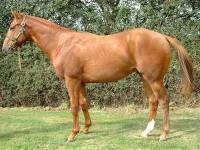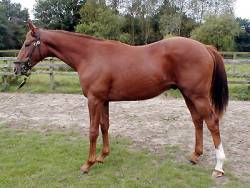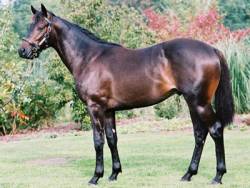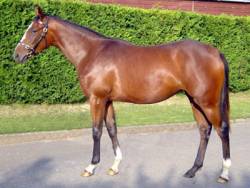

|
|
This article has these aims :-
Initially, let's take one step back and consider why anything, including horse's coats, appear to us as the colours they do? The basic answer is that the substances they are made of reflect light in particular parts of the visible spectrum of light (think of a rainbow as the spectrum range). The combination of visible light light that the surfaces or substances reflect outwards produce the overall colour and shades that we perceive them to be. If no light is reflected the surface or substance will appear black.
Therefore to understand why a horse's coat is a particular colour we need to understand what substances are part of their skin and hair which will cause a particular colour.
In the horse there are two basic substances which the body can produce that can migrate into the coat hairs to provide colour :-
There are three basic colours you will see which are termed CHESTNUT, BAY and GREY. Different combinations of RED and BLACK pigment, or lack of it, produce these three basic types. The section after this will cover other terms you may have seen used such as BROWN and ROAN.
These horses can produce the RED colour (Pheomelanin) but cannot produce the BLACK colour (Eumelanin). The red colour will migrate from the body into the coats hairs and the horse's coat appears reddish brown. Note that other dilution effects can make the red pigment appear as a range of shades, from yellowish brown (often called 'Liver' Chestnut) to darker reddish shades.
The simplest identifying point if you are confused by various shades of brown = there will be no BLACK hairs or patches of skin if it is a Chestnut.


The example pictures show two Chestnut thoroughbreds. Particularly note the lack of any black coloration in the mane and tail as well as no black on the bottom of the legs, muzzle and ear tips.
The way that coat colour is passed to subsequent generations works will mean that around a quarter (25%) of thoroughbreds will be Chestnuts. See later section for an overview of the underlying mechanisms which control coat colour inheritance.
These horses can produce the both the RED colour (Pheomelanin) and the BLACK colour (Eumelanin). The term "BAY" technically describes horses which can produce the BLACK pigment but that it is limited to the tail, mane, bottom of the legs, muzzle and ear tips. Note that the body can be a variety of shades of brown.


The examples above are both "BAYS" despite the different body coat shades. The key identifying features are the black coloration on the bottom half of the legs, tail and mane.
The way that coat colour is passed to subsequent generations works will mean that around three-quarters (75%) of thoroughbreds will be classed as "BAYS". See later section for an overview of the underlying mechanisms which control coat colour inheritance.
The previous sections (A) and (B) covered the two main types of coloured horse ("Red Family" Chestnuts and "Black Family" of which Bays are by far the most common type.). All thoroughbred horses are members of one of these colour "families". Any other coat colour variations are adjustments in some form to these two basic types.
The majority of these "adjustments" are rarely seen but there is one adjustment which accounts for around 4% of thoroughbreds which is the "Grey". The grey coloration has a noteworthiness in thoroughbred racing out of line with its importance. This is partly caused by 'novelty' but also by the positive emotional response greys engender in many people.
However, "Grey" is not a true coat "colour". All horses that are grey are either Red Family or Black Family members. However they have an inherited adjustment which means that from an early age the colour pigments (black and/or red) they produce do not migrate from the body into the coat hairs. The coat hairs will progressively lose all pigment molecules and will eventually appear white. This is the same process as occurs with humans going grey with advancing age.
Both chestnuts and bays can have the grey adjustment.
The article so far has described the two main types of thoroughbred coat colour (Chestnut and Bay) and the major additional effect which can adjust those two basic colour types (greying). This section will briefly address some of the other variations in colour you may see.
Thoroughbreds which are denoted as Brown/Black are part of the same group as Bay horses because they can all produce both the Red and the Black hair pigment. Recall that Bay horses have solid black coloration limited to their tail, mane, bottom of legs, muzzle and ear tips. The Black horse does not have this limit on coloration and therefore the black coloration is all over the body as well. The use of the "Black" definition is rarely used when the initial assessments are made of thoroughbred foals for their passport and stud book registration.
The term "Brown" does not equate to a separate colour type. It appears to be used for a solid, dark brown bay colour in some cases. Thoroughbreds can be registered as "Bay or Brown" which further suggests that "Brown" is not a useful category.
At this point we get into the area of adjustments to the basic colour types which can be applied. The adjustment which produces Grey has already been covered. However there are around 15 other adjustments to the basic Chestnut and Bay groupings that can be applied. Some of these adjustments can interact with each other to produce a variety of colouring effects. An analogy might help - the Chestnut and Bay 'finishes' could be seen as the basic car finishes you will get if you do not specify any modifications. However it is possible to take these basic cars and apply variations like go-faster stripes (white feet/blazes), metallic finishes (roan), etc. But these variations do not change the underlying mechanics or structure of the basic red or black cars you started with.
Roan horses have an adjustment which adds speckling of white hairs within the basic coat colour. Only eight 2yos denoted as roan have run in Britain between 2002 to 2004.
White feet and face blazes represent an adjustment which adds areas (often termed 'paints' or 'splashes') of uncoloured hair to the basic coat colour. Looking at the example pictures of Bays above you will see that one has had three white socks 'overlaid' on the basic black colouring of the bottom of the legs.
This section will provide a non technical overview of how the two basic coat colours are inherited. Remember that this equates to understanding what factors control the ability to produce the Red coloration (Pheomelanin molecule) and the Black coloration (Eumelanin molecule).
The degree to which a quality an individual shows is attributable to their inherited make-up is termed heritability. A quality such as as coat colour is almost completely attributable to the inherited make-up. It therefore has a a high score for heritability. This is expressed as a number between 0 and 1 (equatable to 0 to 100%) and coat colour scores very close to 100%. The high heritability and the ease of identifying different types are the main reasons why coat colour is the most researched area in thoroughbreds.
For comparison consider that in humans a quality such as your preference for horses of a certain coat colour has a heritability score close to zero. This is because this quality is nearly completely attributable to the biases you pick up through your life. A quality such as adult height has an intermediate heritability score because it is affected both by your inherited make-up ("nature") and by the environment you are brought up in ("nurture"). For example the variation in nutrition levels a child gets will have a marked effect on the height it attains as an adult..
(A) WHAT CAUSES THE 75% TO 25% SPLIT OF BAYS TO CHESTNUTS
Explaining the inheritance of Bay and Chestnut colour can be presented as the story of what underlying processes are at work so that you get three-quarters (75%) bays to one-quarter (25%) chestnuts in a population.
All living beings contain in the cells they are made up from sets of instructions which will ultimately be seen as the various characteristics they show. At its simplest these instructions encode for what groups of molecules can be produced; in what places in the body, the order they are produced in and in response to which situations.
These instructions are carried in the cells as multiple sets of crosslinked double strands (try thinking of long, twisted ladders...). Small areas of each of the double strands equate to the production of particular molecules. For example in the case of coat colour small areas will code for the ability to produce black pigment or not, where the black pigment should be produced in the body and so on.
Both the sire and dam of a foal will contain their particular sets of instructions. When the sire produces its sperm (and the same process occurs in the dam when she produces her eggs) these steps take place:-
When the sperm fertilises the egg each set of the two half-ladders (one from the dam's egg, the other from the sire's sperm) combine to produce the full instructions sets for the new horse. These instruction sets will be unique to the new foal and a copy will be produced in each of its cells as it develops and will control the overall development, including factors such as coat colour.
One other item needs to be explained before we can put all of this information together to answer the 75% to 25% question. When two half ladders come together to form the final instruction sets (and remember that particular areas that match up code for particular factors) how do the effects of the two halves work together? Is one half dominant and over the other so that it is always seen in the final horse? Do the two instructions mix to form a mixed result?
Either of the two results are possible. In the case of Chestnut and Bays there are two areas of instructions that matter and both work by one form of the set of instructions being dominant over the other. This means that only the results of the dominant set of instructions will show up in the foal if that dominant instruction is present in either or both of the pair of instructions..
Remember that all of the horses were capable of producing the Red coloration so we can ignore that here. The primary difference between the "Bays" and the "Chestnuts" is that the chestnut horses cannot produce the Black coloration. This ability to produce the black colour molecule is encoded in a specific area of one of the ladders and the format can be:
| SIRE | |||
| Can Produce Black (Bay) | Cannot Produce Black (Chestnut) | ||
| DAM | Can Produce Black (Bay) | (Can Produce Black + Can Produce Black) = "BAY" | (Cannot Produce Black + Can Produce Black) = "BAY" |
| Cannot Produce Black (Chestnut) | (Can Produce Black + Cannot Produce Black) = "BAY" | (Cannot Produce Black + Cannot Produce Black) = "CHESTNUT" |
The table contains the answer to why only 25% of horses will be chestnut. In the random mix-and-match process that takes place to produce the paired instructions relating to black colour production the chestnut must get the instruction to "not produce the black coloured molecule" from both parents. Because the "Can produce black" is dominant it will always win out over the "Cannot produce black" when they are paired together. Therefore only 1 combination out of the four possible will result in a chestnut foal and this is the reason for 25% figure.
WHAT ABOUT THE SPLIT BETWEEN BAY AND BLACK HORSES?
This article has for the most part used "BAY" to mean a horse capable of producing black colouring which is the definition which most closely matches how thoroughbreds are classified and registered by colours. However, in genetic terms "BAY" is used to specifically define horses which can produce black coat colour but have a second dominant instruction area which says "but limit the black areas to the points (a general term which in this context means the mane, tail, bottom of legs, muzzle and ear tips)". All thoroughbreds have this second instruction area including Chestnuts although for obvious reasons the instruction to put limits on the placement of black colour has no effect in a horse which cannot produce that colour.
The table below shows the results of the dominance of the "limit black
to the points" instruction over the "black all over" instruction. This
suggests that 25% of the horses that produce Black pigment should be able
to be classified as "Black". You may care to ponder why it is that during
the 2004 2yo season there were 2010 (i.e. two thousand and ten) 2yos who
were classified as "Bays" and there was 1 (i.e. one, imported after racing
in Ireland) classified as "Black". For the record there were a further
103 horses classified as "Brown".
| SIRE | |||
| Instructions at "Bay" instruction area | Black Colour Only in Points | Black All Over | |
| DAM | Black Colour Only in Points | (Black Colour Only in Points + Black Colour Only in Points) = "BAY" (or Chestnut) | (Black All Over + Black Colour Only in Points) = "BAY" (or Chestnut) |
| Black All Over | (Black Colour Only in Points + Black All Over) = "BAY" (or Chestnut) | (Black All Over + Black All Over) = "BLACK" (or Chestnut) |
There are two other points of interest to note from the table. Each result section has "(or Chestnut)" in it to make the point that this evaluation of the effect of this instruction area occurs in Chestnuts too but has no effect on the individual's coat colour. However it does have an effect if the individual breeds because it will contribute one of the instruction pairs in this area. For example it is possible for a "Bay" and "Chestnut" pair of parents to produce an all over black offspring.
The second point to note is that you are probably already thinking that this is getting complicated - and you're right. You might be asking whether you need to know this in any detail - and the answer is "No". However, remember that the two instruction areas above are but two of around twenty different (known) instruction areas which contribute to the final coat colour. You already know about a third which is the instruction area which produces "Greys" (a choice between allowing or stopping colours into the hairs).
Also consider that some of these more minor instruction areas don't
work in a 'serial' manner (like 'stops' on a production line) but interact
with each other and produce different results depending on the instruction
pairs in other areas. All of that complexity to do a relatively simple
job like defining the coat colour.
{ As an aside it is worth considering that it is the lack of knowledge
of how the random process works (and many others),, and how it could be
controlled, that makes thoroughbred breeding a hit-and-miss process. At
present we have almost no idea which areas of which 'ladders' affect the
various factors in athletic ability (muscle type, respiratory systems etc.).
Also the different areas interact with each other in complex ways and are
overlaid with control processes (e.g. turning on/off the production of
molecules) that we don't understand at all. Its science fiction at present
but in principle there's no reason why in future we couldn't produce the
'perfect racehorse'. If we knew which were the best instructions to have
in each area of each ladder and had the mechanisms to arrange for the correct
placement of instructions it could be done.
Back in the current real world we are in a situation where Thoroughbred
Breeding really is "Breed the best to the best and hope for the best".
It also raises the point that should be wary of any claims of prediction
of athletic ability of an individual horse through 'Pedigree Analysis'.
The random nature of the underlying processes militates against this type
of prediction. At best it might be used to indicate a slight likelihood
across a large population (e.g. all of a sire's 1000+ foals). What 'pedigree
analysis' probably tells you is which pedigrees 'pedigree analysts' currently
think are likeable and fashionable. Which is somewhat circular but nevertheless
useful if that opinion has a practical bearing on the prices a young thoroughbred
will fetch at a sale.
To take this further it is slightly odd that Sales Catalogues publish
pedigrees with half brothers and sisters of the horse missed out but details
of better horses under the 2nd, 3rd, 4th and even 5th dams. Since we can't
predict how alike two full brothers will be what is the reason (other
than historical interest) for these listings? For example an auctioneer
might announce that a horse by the 3rd dam of the current lot for has won
a big race, the inference is presumably that this has a positive effect
on the lot for sale. It, of course, has no effect at all and the auctioneer
could equally read out the list of other offspring down the dam-side 'family'
which have proved average, moderate or useless athletes since they have
the same level 'relatedness' (or unrelatedness depending upon your view.
Given the level of inbreeding in the thoroughbred if you picked two horses
at random they would be as 'related' in genetic terms as 1/2 brothers so
trying to infer some link between the offspring of a third dam is not valid).
This again suggests a lack of knowledge being replaced with fashion and
probably, to use the current word in vogue, spin. }
(B) SIRES AND COAT COLOUR OF THEIR OFFSPRING
This section provides an example of how the instruction pairs effect the colours of offspring you see from sires. You may have heard the term used "pure breeding bay". This is used to refer to a "Bay" sire that has the following instruction pair from Table 1. above - (Can Produce Black + Can Produce Black) = "BAY" . Since this type of sire can only contribute the instruction "Can Produce Black", and because this is dominant over the opposite instruction all of the offspring from this sire will produce black coloration and will almost certainly be registered as Thoroughbred "Bay".
Good examples of "pure breeding Bay" sires are Sadler's Wells, Cape Cross and Marju.
A "Bay" sire who has an instruction pair where one says "Can Produce Black" and the other "Cannot Produce Black" will produce offspring where the majority are "Bay" but around 25% will be Chestnuts. Examples of these sires are Night Shift, Efisio and Daylami (yes, he was classified as "Grey" but underneath that 'adjustment' he was a bay horse with a mixed pair of instructions in this area).
A Chestnut sire will, of course, have both instructions in this area set to "Cannot Produce Black". This type of sire will produce both Bays and Chestnuts in roughly equal numbers.
This may, or may not be a question you have considered. It is raised here partly to make the point of how British racing has examples of biases which are, at best unproven, and almost certainly entirely wrong. You may have heard expressions of bias for and against certain coat colours in various forms. The most common examples are :-
Therefore the three examples above should be read as the individual preference of the person making the statements. For example the use of the phrase "good colour" to describe a horse is meaningless other than for the individual using the phrase and anyone who understands and agrees with their personal bias.